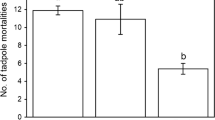Abstract
Caddisfly larvae are typically restricted to benthic microhabitats due to the presence of mobile tubular cases constructed out of mineral or organic material. Members of one family (Leptoceridae) use setae on extended metathoracic legs to swim. We describe the swimming behavior of a North American caddisfly, Triaenodes tardus, and experimentally evaluate two hypotheses proposed to explain this behavior. Triaenodes swam 1.47 cm/s, while carrying almost twice their mass in the case material. The larvae employ a stereotypic sequence of motions that likely reduce resistance during the upstroke and increases forward momentum during the downstroke. When placed on substrates of different sizes, larvae swam more on fine sediments but did not elevate off the sediment. After larvae were provided with living or artificial vegetation, the number of swimming bouts decreased compared to a pre-treatment observation period. These results indicate swimming likely does not function to facilitate movement off fine sediments, but rather, helps larvae locate and move between aquatic macrophytes which are the primary habitat of this, and other, swimming species.





Similar content being viewed by others
References
Abrahams M, Kattenfeld M (1997) The role of turbidity as a constraint on predator-prey interactions in aquatic environments. Behav Ecol Sociobiol 40:169–174
Bennett AF (1989) Integrated studies of locomotor performance. In: Wake DB, Roth G (eds) Complex organismal functions: integration and evolution in vertebrates. Wiley and Sons, New York, pp 191–202
Berg CO (1949) Limnological relations of insects to plants of the genus Potamogeton. Trans Am Microsc Soc 68:279–291
Betten C (1934) The caddis flies or Trichoptera of New York State. Bulletin New York State Museum 292:576p
Blake RW (2004) Fish functional design and swimming performance. J Fish Biol 65:1193–1222
Brett MT (1989) The distribution of free-swimming macroinvertebrates in acidic lakes of Maine: the role of fish predation. Aqua Fennica 19:113–118
Brodie ED Jr (1983) Antipredator adaptions of salamanders: evolution and convergence among terrestrial species. In: Margaris NS, Arianoutsou-Faraggitaki M, Reiter RJ (eds) Plant, animal and microbial adaptations to terrestrial environment. Plenum, New York, pp 109–133
Carrier DR (1987) The evolution of loomotor stamina in tetrapods: circumventing a mechanical constraint. Paleobiology 13:326–341
Cloudsly-Thompson JL (1956) Studies in diurnal rhythms: VII. Humidity responses and nocturnal avtivity in woodlice (Isopoda). J Exp Biol 33:576–582
Darwin C (1859) On the origin of species by means of natural selection, or the preservation of favoured races in the struggle for life. Murray, London
Darwin C (1871) The descent of man and selection in relation to sex. Murray, London
Dodds GS, Hisaw FL (1925) Ecological studies on aquatic insects. III. Adaptations of caddisfly larvae to swift streams. Ecology 6:123–137
Domenici P, Blake RW (1997) The kinematics and performance of fish fast-start swimming. J Exp Biol 200:1165–1178
Freeman S, Herron JC (2007) Evolutionary analysis, 4th edn. Prentic Hall, Upper Saddle River
Gall BG, Brodie ED Jr (2009) Behavioral avoidance of injured conspecific and predaotry chemical stimuli by larvae of the aquatic caddisfly Hesperophylax occidentalis. Can J Zool 87:1009–1015
Glover JB (1996) Larvae of the caddisfly genera Triaenodes and Ylodes (Trichoptera: Leptoceridae) in North America. Bull Ohio Biol Surv 11:1–89
Grant PR, Grant BR, Smith JNM, Abbott IJ, Abbott LK (1976) Darwin’s finches: population variation and natural selection. Proc Natl Acad Sci USA 73:257–261
Haddock JD (1977) The biosystematics of the caddis fly genus Nectopsyche in North America with emphasis on the aquatic stages. Am Midl Nat 98:382–421
Jamieson GS, Scudder GGE (1979) Food consumption in Gerris (Hemiptera). Oecologia 30:23–42
Johansson A (1991) Caddis larvae cases (Trichoptera, Limnephilidae) as antipredatory devices against brown trout and sculpin. Hydrobiologia 211:185–194
Lillywhite HB (1970) Behavioral temperature regulation in the bullfrog, Rana catesbeiana. Copeia 1970:158–168
Mackay RJ, Wiggins GB (1979) Ecological diversity in Trichoptera. Annu Rev Entomol 24:185–208
McGaha YJ (1952) The limnological relations of insects to certain aquatic flowering plants. Trans Am Microsc Soc 71:355–381
O’Steen S, Cullum AJ, Bennett AF (2002) Rapid evolution of escape performance in Trinidad guppies (Poecillia reticulatus). Evolution 56:776–784
Oakley B, Polka JM (1967) Prey capture in dragonfly larvae. Am Zool 7:727–728
Otto C, Svensson BS (1980) The significance of case material selection for the survival of caddis larvae. J Anim Ecol 49:855–865
Tindall AR (1964) The skeleton and musculature of the larval thorax of Triaenodes bicolor Curtis (Trichoptera: Limnephilidae). Trans R Entomol Soc Lond 116:151–210
Wiggins GB (1996) Larvae of the North American caddisfly genera (Trichoptera), 2nd edn. University of Tortonto Press, Toronto
Wiggins GB (2004) Caddisflies: the underwater architects. University of Tortonto Press, Toronto
Williams DD, Tavares AF, Bryant E (1987) Respiratory device or camouflage?—a case for the caddisfly. Oikos 50:42–52
Wissinger SA, Whissel JC, Eldermire C, Brown WS (2006) Predator defense along a permanence gradient: roles of case structure, behavior, and developmental phenology in caddisflies. Oecologia 147:667–678
Acknowledgments
We are grateful to Kip and Cristy Christen for access to their pond and permission to collect invertebrates; without such kindness, this research would not be possible. We also thank Dave Ruiter for assistance with insect identification, and scientific illustrator Bronwyn F. McIvor for her excellent line drawings in Fig. 1. This research was financially supported by the Utah State University Department of Biology, and a Natural Sciences and Engineering Research Council of Canada (NSERC) Postgraduate Scholarship to GRH.
Author information
Authors and Affiliations
Corresponding author
Rights and permissions
About this article
Cite this article
Gall, B.G., Hopkins, G.R. & Brodie, E.D. Mechanics and Ecological Role of Swimming Behavior in the Caddisfly Larvae Triaenodes tardus . J Insect Behav 24, 317–328 (2011). https://doi.org/10.1007/s10905-011-9260-1
Revised:
Accepted:
Published:
Issue Date:
DOI: https://doi.org/10.1007/s10905-011-9260-1




